All Rights reserved
By continuing to use our site, you agree to our Privacy Policy and Terms of Use.
By Lisa Morrow, CNN
(CNN) – The Greek island of Samothrace is a vision in green. The craggy rocks of Mount Saos, the island’s highest mountain at 5,285 feet (1,611 meters), give way to gentle slopes covered in oddly shaped plane trees, oak woodlands and majestic cedars.
Fed by the clear waters of three rivers, rare and endemic plants flourish. Vegetables thrive in fields around the port of Kamariotissa near the island’s western tip, while olive trees and solar panels line terraces carved out along the southern coastline.
Located in the Aegean Sea near Greece's northeastern border with Turkey – the island is a short ferry ride from Alexandroupoli on the mainland – Samothrace was once known across the ancient world for its religious sanctuary. Today it’s a magnet for ecotourists. Here are some of its highlights.An island of ‘young feet’
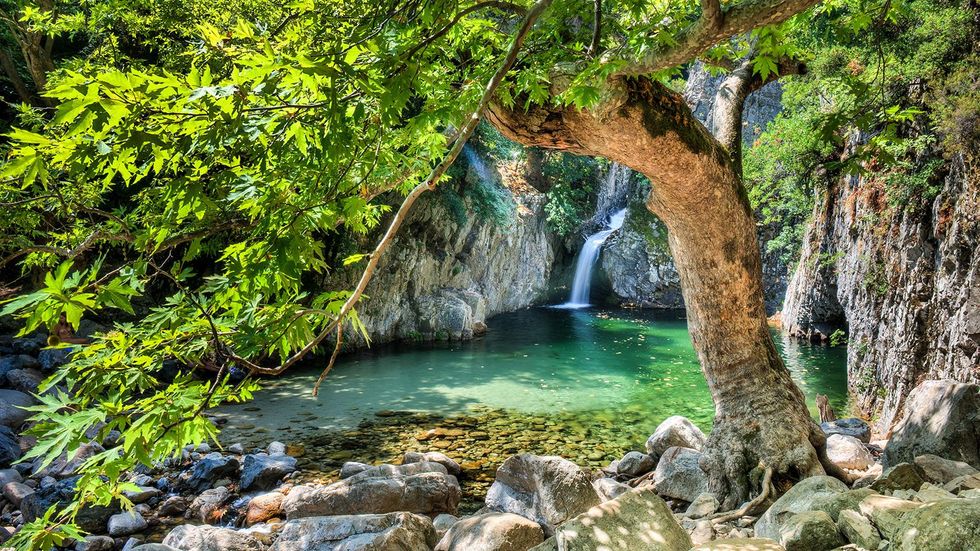
The Greek Island of Samonthrace
PHOTO BY CATALINEREMIA/ADOBE STOCK
Therma on the north coast is a good base for exploring the island. Most of the accommodation here is simple, focusing on engaging with the environment as much as possible. Who needs luxury when there's a creek playing a symphony outside your window?
Nature is what it’s all about, according to Kaliopi Parselias, owner of Parselias Studios for more than 30 years. “Samothrace is a different island,” she says. “You have green forests, rivers, waterfalls, and people come to walk up the mountain and some people love the sea. It is a virgin island.”
Parselias has run the B&B for more than 30 years, and initially their guests were mainly Greek families with a few Germans. “But now we have people from all over Europe,” she says. With just one caveat: “Young people, because Samothrace needs young feet for walking.”
Many of them choose to stay at Camping Varades, right next to the sea, named after “varades,” a kind of beehive inside hollow trees, explains manager Anastasios Vavouras. Bees work as a cooperative, of course, and the campsite is collectively owned by seven people. Their aim, he says, is to offer visitors “an alternative way of spending their holidays here... focused on mountain activities, in a quiet, more free environment.”
The majority of campers are Greeks in their 20s and 30s, like Giannis Tsakiltsidis, a student from the mainland on his first visit to the island. “You can spot campers of all ages, here to experience a more undisturbed and more undiluted view of Greece,” he says.
Tsakiltsidis has come here to hike. Ancient paths crisscross the mountains and the hikes range from being suitable for beginners through to more serious trekkers.
River hikes and waterfall pools
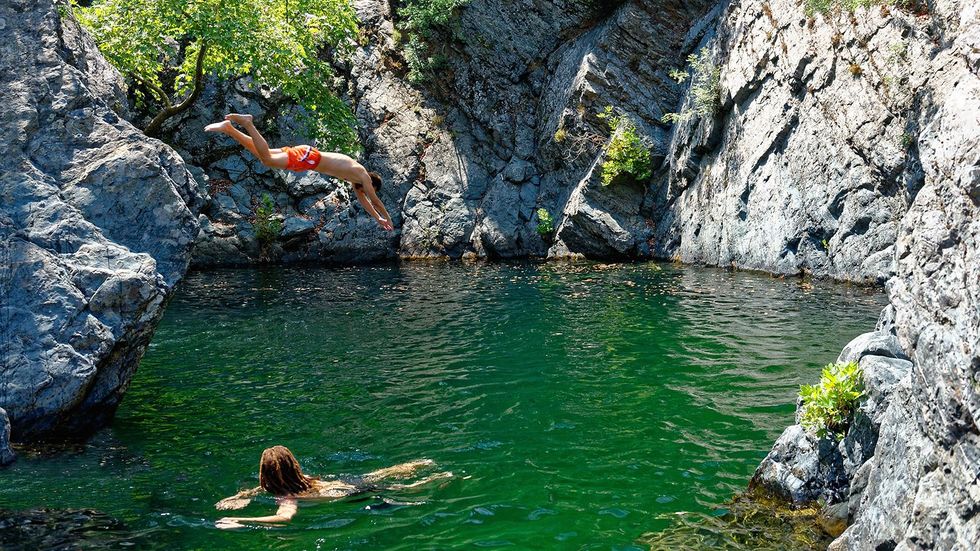
The island is known for its ‘vathres,’ or waterfall-fed pools.
PHOTO BY CATALINEREMIA/ADOBE STOCK
Across northern Samothrace, waterfalls cascade over smooth rocks forming vathres, naturally occurring river pools. The three on the Tsivdogiannis River, just outside Therma, are the easiest to reach. It’s impossible to touch the bottom of the first vathra with your feet, but Gria Vathra, the second, is not so deep. Naked hippies appear like water nymphs, gliding past clothed swimmers with aplomb. They wade through the water, scant belongings bundled on their heads, before clambering across and up a rock face to the third pool.
Three more vathres are located on a track starting around three and a half miles further east of Therma along the coastal road. The river flowing through these is the Fonias, which starts at Mount Saos and flows out into the sea. Fonias means “killer” in Greek, which definitely suits its brutal power when the water overflows. In dry weather, however, the path to the first vathra is a fairly easy walk of under one hour. Families, some with toddlers, skirt the riverbed alongside huge plane trees, gold-tinted bracken, and aged gray stones.
At the first waterfall, also called Fonias, people sun themselves as children paddle in the shallow outer ponds, and swimmers attempt to stay put under the bracingly strong falls of the first vathra. Halfway up the rock face there’s a rope attached to a tree. The brave swing out, Tarzan-style, before torpedoing into the icy waters below.
The second vathra, Gerania – which is also fed by a waterfall – is a further 30-minute hike.
The fashionably young attempt the ascent clad only in bikinis and sneakers, but hiking boots are useful. The first section involves a steep climb aided by a metal cable, then a challenging zig-zag up a dry watercourse leading to a level narrow track edging around the mountain, (only some of it is fenced). A brief final descent reveals your reward: a shimmering iridescent green body of water. Blue-bodied, black-winged dragonflies, each marked with a single yellow dot, skitter away across the surface, as the humans continue unperturbed with their cleansing rituals.
The path leading to Kleidosi, the third waterfall, is also nicknamed “killer,” and for good reason. It’s not recommended.
From the mountains to the sea
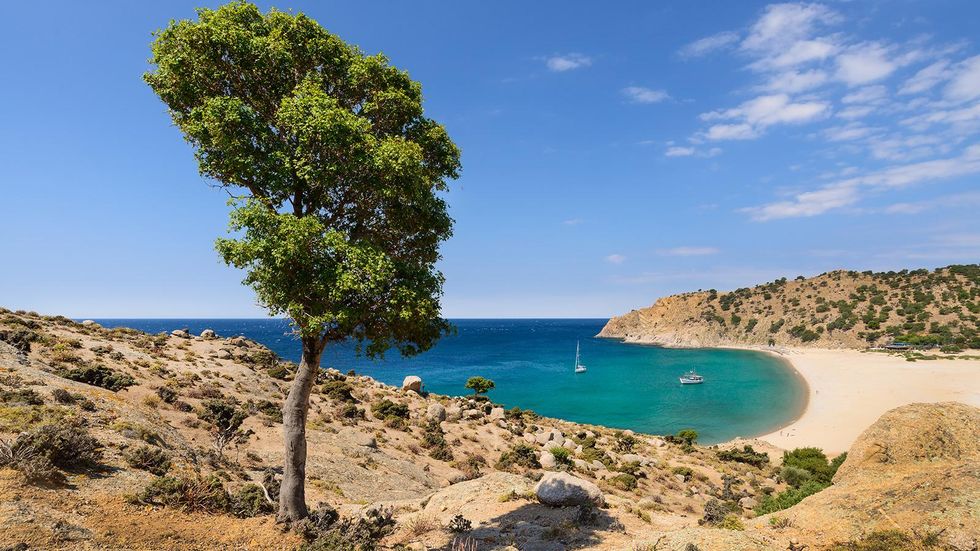
Pachia Ammos is the island’s only sandy beach.
PHOTO BY GIOVANNI RINALDI/ADOBE STOCK
The round trip from Therma to the peak of Fengari, as the Greeks call Mount Saos, is just over 11 miles but according to Vavouras, only the “most daring” aim for the top. “It’s a difficult path to climb, but there are structured paths so you're not at any risk of any danger, slipping or falling,” he says. Like many trails on the island, this one comes with warning signs along the way. Remember, you're on your own if anything goes wrong.
For the less energetically inclined there are springs-fed thermal baths in Therma dating back to Byzantine times, plus beaches everywhere. Kipos, near the eastern coast, has beautiful bluish-colored pebbles while Pachia Ammos in the south is the island’s only sandy beach. Boat trips starting from Kamariotissa or Therma stop at Vatos Beach (near Pachia Ammos but otherwise only accessible via a grueling hike), and take you past Kremasto Nero. Meaning “Hanging Waterfall,” at full flow the water plummets directly into the sea without touching the cliffs, hence the name.
Further round the south coast, stark gray rocks loom menacingly over the waves, covered in what looks like a giant work of abstract art. This is Tis grias ta pania, or “old lady’s laundry.” Legend has it that one day a fierce wind blew a woman’s washing onto the rocks. Angry at her loss she rained out curses, turning her clothes to stone.
Ancient remains
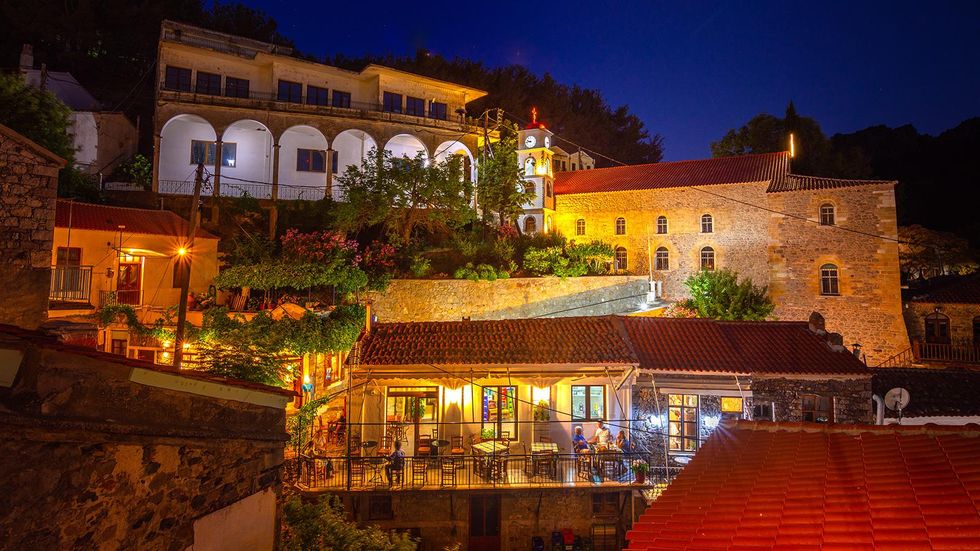
Medieval Chora is the island's main town.
PHOTO BY GATSI/ADOBE STOCK
History buffs are also catered for on Samothrace. The Arsinoëion, or Sanctuary of the Great Gods, is where the statue of Nike, known as the “Winged Victory of Samothrace,” was found. Sculpted in the second century BCE and now displayed in the Louvre, it’s one of the most famous ancient works of art. The temple pre-dates the time of classical Ancient Greece, and was once the religious center of the North Aegean. It's been partially reconstructed and there’s a replica of the Nike in the small museum.
Chora
Set high up on Mount Saos, Chora is the island’s capital. At the citadel built in the 15th century by Genoese ruler Palamedes Gateluzzi, it’s worth grabbing a coffee from the cafe at its base and enjoying the view of town. There are pretty streets to wander where flowers spill from window boxes and tree branches create canopies over restaurants and cafes.
The small Folklore Museum of Samothrace is laid out like a traditional village home, filled with religious icons, photographs, and household items. Look out for a raki still that looks like an enormous turkey baster, with a bulb made from copper and a long metal nozzle attached. As well as regular souvenirs like magnets and windmills you can also buy shepherds’ crooks.
Goats, veggies, and hippies
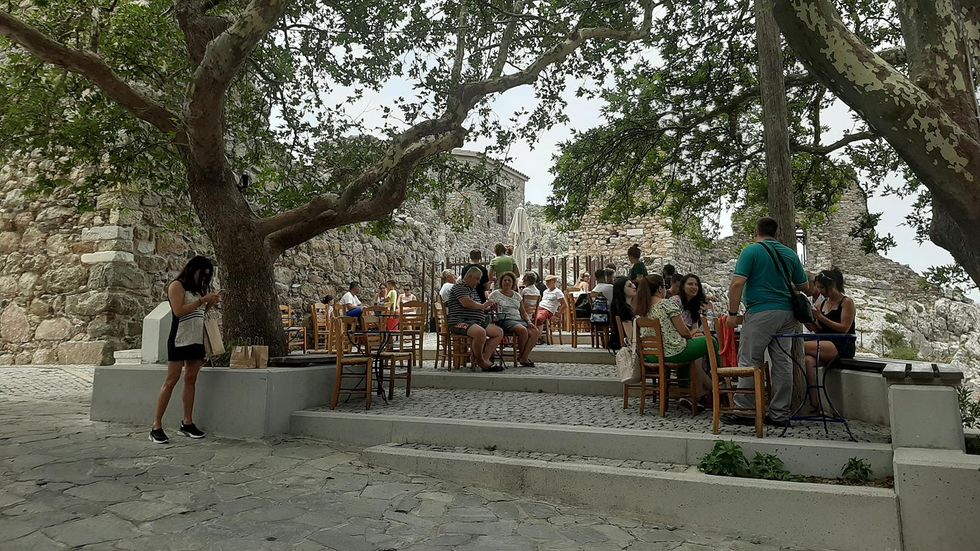
Visitors embrace the island’s laidback lifestyle
PHOTO BY LISA MORROW
There are goats everywhere on Samothrace. In the simply named Goat Shop in Chora they’re on T-shirts, bags, and bandannas. Elsewhere they loiter aimlessly on roads, stand on branches chewing mindlessly, and foraging among the walnut trees. “Our goats are famous throughout Greece,” says Parselias – but not for the reason you might think. “They graze near the sea, so they’re very tasty.”
The best goat dishes are found inland at family-run restaurants in leafy forests or with gorgeous sunset views. Bare-chested youths mingle with multi-generational families, up to their elbows in goat meat washed down with glasses of ouzo or Fonias beer from the island’s microbrewery. Locals have more than 20 different ways to prepare goat. Whether cooked in the oven with plums, marinated in red wine, or smothered in quince, almost everything on the menu is bred, grown, or made by the people serving you.
It's not all meat, though – there’s great seafood, as you’d expect from a Greek island, and vegetarian specialties include fasolada tsigirista, a bean stew that’s cooked and allowed to sit for a day before being fried. Several Therma restaurants have vegan options including non-dairy versions of spanakopita, a traditional Greek pie usually made with spinach and feta.
Some restaurants sell their products on-site, and you can buy cheese, honey and olive oil direct from farms around the island.
Partying with the hippies
At night Therma comes alive with a street market. Islanders sell well-crafted jewellery using semi-precious stones, hand-tooled leather bags, and more. Dreadlocked women in tiny tops and bearded men in baggy shorts drift slowly into town. They dine late, talking excitedly, before falling silent to listen to haunting renditions of traditional songs. Before long, everyone joins in. When the moon is full, it’s time to party – in an environmentally aware manner of course.
The people working in tourism on Samothrace have grown up here, and none of them take its wild beauty for granted. They work together to protect it, because as Parselias says: ‘Samothrace has very good energy. People say it is calm. When they come here they are tired, have many problems. After one week, they are new people.”
Whatever you come for – whether it’s the walking, the beaches, or the food – she knows you’ll be back.
The-CNN-Wire
™ & © 2023 Cable News Network, Inc., a Warner Bros. Discovery Company. All rights reserved.












































































